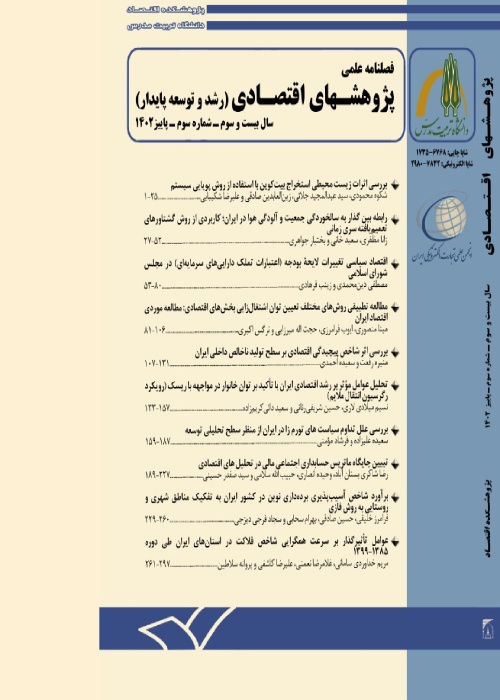The Effect of Oil Price Shocks on Labor Market Components
The purpose of this study is to investigate the effect of oil price shocks on the components of the Iranian labor market and the role of government capital expenditure in this field. Labor market components include job vacancies, job finding rates, inflow rates to unemployment and unemployment rates. For this purpose, the structural vector autoregressive approach over the period 2005:2- 2019:3 has been used. The results of impulse response functions show that positive oil price shocks have significant effects on model variables. However, negative oil price shocks are not significant. The positive oil price shock increase government capital expenditure, but due to the inefficiency of government investment, job vacancies decrease and the inflow rates to unemployment increase. As a result, the unemployment rate has risen in response to positive oil price shocks. The results show the Dutch disease and the asymmetric effect of oil price shocks on the labor market.
In addition to creating economic problems, the problem of unemployment can be the source of behavioral disorders and political tensions and can be considered a threat to the health of a society. For this reason, analyzing the labor market and knowing the factors that lead to unemployment is one of the concerns of every economy. Oil is a source of income in exporting countries and an important production factor in importing countries. Therefore, oil price shocks are expected to have an impact on market developments in terms of income and cost effects. This study aims to answer the question of whether oil price shocks have an effect on the components of Iran's labor market. For this purpose, the effect of oil price shocks from the channel of construction expenditure on the rates of finding a job, entering unemployment, unemployment and job opportunities, which are adjustment factors and represent the components of the labor market, are investigated.
In this article, structural vector auto regression (SVAR) model is used to investigate the effect of oil price shock on labor market components. For this purpose, it is necessary to specify the VAR model first, and then analyze the SVAR model by applying restrictions on matrices A and B. Constraints are imposed on the relationships between the regression residuals and the disturbance terms of the structural equation system so that the structural form can be identified.
The results related to the significance of the variables show that all the variables are at the significance level. In addition, the optimal lag for estimating the basic VAR model based on the Akaike criterion is 1. Examining the roots of the VAR equation system shows that all the roots are less than one and are inside the unit circle, so the effects of shocks disappear in the long-run and the system is stable. The findings show that one standard deviation shock to the series of positive changes in oil price causes its instant increase by 0.4 and its effect decreases in the second season and disappears from the third season onwards. Government construction expenditure has increased immediately in response to shocks (one-time lag amounts), but this increase is not lasting, and it has declined in the second season, and in the third season it disappears with a slight increase in shock effects that shows a strong dependence on oil revenues. Because the only source of construction expenditure is from oil revenues, job openings have declined due to these shocks, which last until the second season. Then it increases slightly, but less than the initial negative effect, and gradually the shock effect disappears. One standard deviation shock to the series of negative oil price changes will cause it to increase by 0.1 immediately, and its effect will disappear in the third quarter. The effect of negative oil price shocks on any of the variables is not significant. However, these shocks immediately reduce government construction spending. This again shows the dependence of construction expenditure on oil revenues because at the time of the drop in oil prices, construction expenditure is decreased and allocated to current expenditure.
The aim of this study was to investigate the effect of oil price shocks on the labor market. For this purpose, the effects of positive and negative shocks of oil prices on construction expenditure, job opportunities, and unemployment rates, entering unemployment and finding jobs in a SVAR model were investigated. Positive (negative) shocks in oil prices immediately increase government construction spending. This increase (decrease) is not lasting and quickly decreases (increase) and from the third season onwards, the shock effects disappear. The positive shock of oil prices has a significant effect on four components of labor market, namely job opportunities, entering unemployment, job finding rate and unemployment rate. However, negative oil price shocks are not meaningful. Therefore, oil price shocks have asymmetric effects on the labor market. The results also confirm two problems of dependence on current expenditure and Dutch disease. Because shocks only affect the short term, while construction spending is expected to improve job opportunities in the long run.
- حق عضویت دریافتی صرف حمایت از نشریات عضو و نگهداری، تکمیل و توسعه مگیران میشود.
- پرداخت حق اشتراک و دانلود مقالات اجازه بازنشر آن در سایر رسانههای چاپی و دیجیتال را به کاربر نمیدهد.


